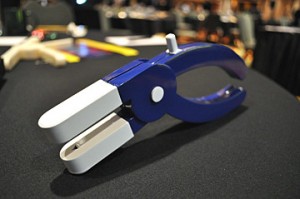A team of biomedical engineering students at Johns Hopkins University in Baltimore developed a disposable suturing tool for abdominal surgeries, to reduce the risk of complications, such as the accidental puncture of internal organs. The students, mainly undergraduates, filed a patent for their FastStitch device, and started a company to take their idea to market.
The student team led by Sohail Zahid started on the project as a class assignment over the past year to design and test a tool that would improve the way surgeons stitch together the strongest part of the abdomen, the muscle layer called the fascia. The team says some 5 million open abdominal surgeries are conducted annually in the United States alone to treat disorders such as cancer and liver problems. If incisions from those procedures are not closed properly, a patient can develop complications such as sepsis or other infections, herniation, and evisceration, all of which require additional treatment and in some cases, more surgery.
The fascia is located just below the patient’s skin, and as noted by team member Luis Hererra, “Doctors who have to suture the fascial layer say it can be like pushing a needle through the leather of your shoe.” The students designed the FastStitch specifically for the fascia, which they say works as a hybrid of a pliers and a hole-puncher, with a familiar hand-size pliers-like shape.
The needle in the FastStitch remains housed in the jaws of the stitching tool, with the fascia layer placed between the top and bottom arms of the device. “As you close the arms, the spring-loaded clamp is strong enough to punch the needle through the fascial layer,” says Zahid. “When this happens, the needle moves from one arm of the tool to the other.” The device includes a visual guide to help ensure that stitches are placed evenly, located the proper distance away from the incision and apart from one another.
Hien Nguyen, an assistant professor of surgery at the Johns Hopkins medical school and an advisor to the students, says the FastStitch “allows the surgeon to bring the muscle layers back together evenly, safely and quickly, and this can lead to better outcomes and fewer complications.”
The students built a prototype device from acrylonitrile butadiene styrene (ABS), a common and inexpensive plastic, which could make it possible to manufacture FastStitch at a low enough price for it to be disposable. The team members have obtained preliminary patent protection for their device through the university’s technology transfer office.
To bring the FastStitch to market, the students started a company, Archon Medical Technologies, located in Baltimore. The company, say the students, will continue conduct further research and development of FastStitch, including animal and human cadaver testing. Archon Medical Technologies has accumulated $80,000 in grants and prize money, including first-place finishes in University of California, Irvine, and University of Maryland business plan competitions.
The following video tells more about FastStitch.
- Undergrad Engineers Design Improved Neck Stabilizer Brace
- Students Engineer Bread Yeast to Yield More Nutrients
- Grad Students Develop Cord Blood Stem Cell Collection Device
- Student Engineering Works Become Products for Disabled Vets
* * *


 RSS - Posts
RSS - Posts
[…] Hopkins Students Invent Suturing Device, Start Company […]
[…] Hopkins Students Invent Suturing Device, Start Company […]